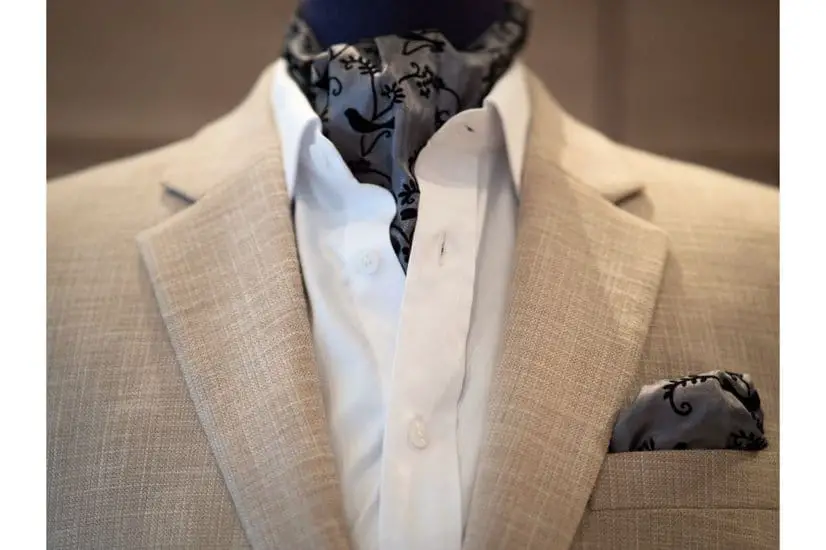Cravat vs Ascot – A long Debate!
Fashion trends come and go, as anyone who works in the industry will tell you. We as a culture have an unshakeable desire to revisit those places from the past – often with very thick-lensed rose-colored glasses – and bring some of those periods’ most distinguished bits of fashion back to our present. Frequently with varying degrees of success.
Despite our collective nostalgia for the eras we never knew, you’d be hard-pressed to find someone willing to venture further back than the 20th century and my modern society’s formative years for more interesting bits of apparel. (Here’s hoping for the glorious return of the top hat).
Luckily, a lot of what was common – and indeed, fashionable – back then has survived into our current milieu, albeit in slightly different forms. And as you may have guessed from the title of this article, we’re going to explore two of our forebears’ fashion heirlooms and settle the differences between them once and for all.
A (Brief) History of the Cravat
The first thing to understand is that the cravat (from the French la cravate) is a predecessor to the modern ascot. A thing’s history is as important as its present and, as you will find, the history of one is also the history of the other. With that in mind, let us examine – briefly – the quaint story of the cravat.
Although the Romans were the first to wear knotted kerchiefs around their neck, modern western society was first introduced to the cravat by the Croats in the 1660s. It was the French who first took notice of the unusual yet picturesque bit of neckwear during the reign of Louis XIV, who had enlisted Croatian mercenaries and brought them to Paris. The garment was originally admiringly called a Croat, but was soon changed into the more Eurocentric cravate.
The cravat gained further popularity in other parts of Europe when Charles II returned from his exile and brought with him the latest trends in fashion. Meanwhile, back in France, the wars of Louis XIV continued to be waged, and while French society (particularly the nobility) had lovingly adopted the cravat, the soldiers soon discovered its impracticality.
While the cravat was typically a flowing garment tied with a bow knot, the soldiers wore a far more mundane necktie, wrapped only once about the neck and tied in a loose knot. This iteration came to be known as the Steinkirk, so named after the Battle of Steenkerque in 1692.
Indeed, though the Steinkirk lost popularity in the years after, the flowing cravat was still fashionable, particularly among the Maccaronis in England. It became a staple of Victorian fashion, and the manner in which a man knotted and wrapped his cravat was indicative of his taste and style. The numerous forms – both traditional and outlandish – warranted a broader form of categorization. And after the Battle of Waterloo, the cravat – in all its forms – had a new name: the tie.
What About Ascots?
From this brief look into the history of the cravat, two inferences can be drawn. The first is that the cravat predates the ascot by at least a century and a half. Secondly, though their use varies today, they share a history, for, without the one, we probably would not have the other.
The ascot as we know it today came into being in the 19th century and saw a quick increase in popularity around 1880. It shares many similarities with its predecessor but is generally accepted to be the looser of the two and thus more universally accepted. It was traditionally worn for formal daytime events and took its name from the Royal Ascot race meeting.
Of course, the ascot is most commonly associated with both the United States Navy and a certain blonde-haired companion of a certain talking dog.

What Are the Differences Between Ascots and Cravats?
Though the history of these two seminal pieces of neckwear may seem trivial, we believe that it is important to know in order to understand the myriad of similarities and differences between them. The simple truth is this: the differences between them (cultural and historical associations aside) are rather minute. That being said, let us examine the few characteristics of both items that serve to set them apart.
Ascots
In general, thanks to some linguistic technicalities, the ascot is considered to be a traditional element of formal wear. Typically, the ascot is tied similarly to the more common necktie and secured to the outside of the shirt by a pin. This, and this alone, is the only thing truly separating ascots from other forms of neckwear.
Because the English language often comes up short when it is most needed, not many people can agree on what an ascot is. Of course, we know it to be the item we have just described, but plenty of people use the terms “ascot”, “necktie”, and “cravat” interchangeably.
Cravats
Put simply: all ascots are cravats, but not all cravats are ascots.
That being said, you are more likely to encounter cravats – or at least, what people might call cravats – at formal gatherings such as weddings. The older cravats of yesteryear were typically made of thicker material and tied in elaborate fashions, but you are unlikely to encounter anyone who still adheres to the traditional use of the cravat.
Final Thoughts
It is more than likely that we have missed a few details in our account of the history of the cravat (and, by extension, the ascot). However, we feel that we have effectively demonstrated the connection between the two, which should hopefully settle any further “cravat vs ascot” debates going forward.
Of course, the English language is only so extensive. You may still encounter some who refer to cravats as ascots and vice versa. We highly recommend that you do not recount the history of the cravat to them, should you wish to remain friendly. We hope you can now go out assured in the knowledge that you know the difference between the two terms and can enjoy wearing both.
Next, feel free to check out the history of Bolo Ties and how to wear one with style.

Samoel Ovanessian is the founder and creator of StylishAlpha.com – a website dedicated to men’s fashion. As a proud owner of more than 200 ties, he loves digging through new clothing combinations for everyday use, formal events and even just for fun. You can read more about Samoel here.

